University Name - Leadership Reflective Journal: Chapters 1-12
VerifiedAdded on 2023/06/03
|8
|2048
|451
Journal and Reflective Writing
AI Summary
This reflective journal explores various facets of leadership, analyzing leadership styles, traits, and theories based on chapters 1-12. The journal begins with an exploration of leadership concepts, distinguishing leaders from managers, and examines the evolution of leadership thought. It further delves into the personal side of leadership, emphasizing the importance of vision, risk-taking, and trustworthiness. The journal also highlights the significance of relationship building, effective communication, and team dynamics in achieving organizational goals. The author reflects on the impact of personal traits, self-assessment, and the cultivation of relationships on leadership effectiveness. The journal covers topics like transformational leadership, Bass theory, and the importance of building relationships. The author references scholarly articles to support their reflections on leadership.
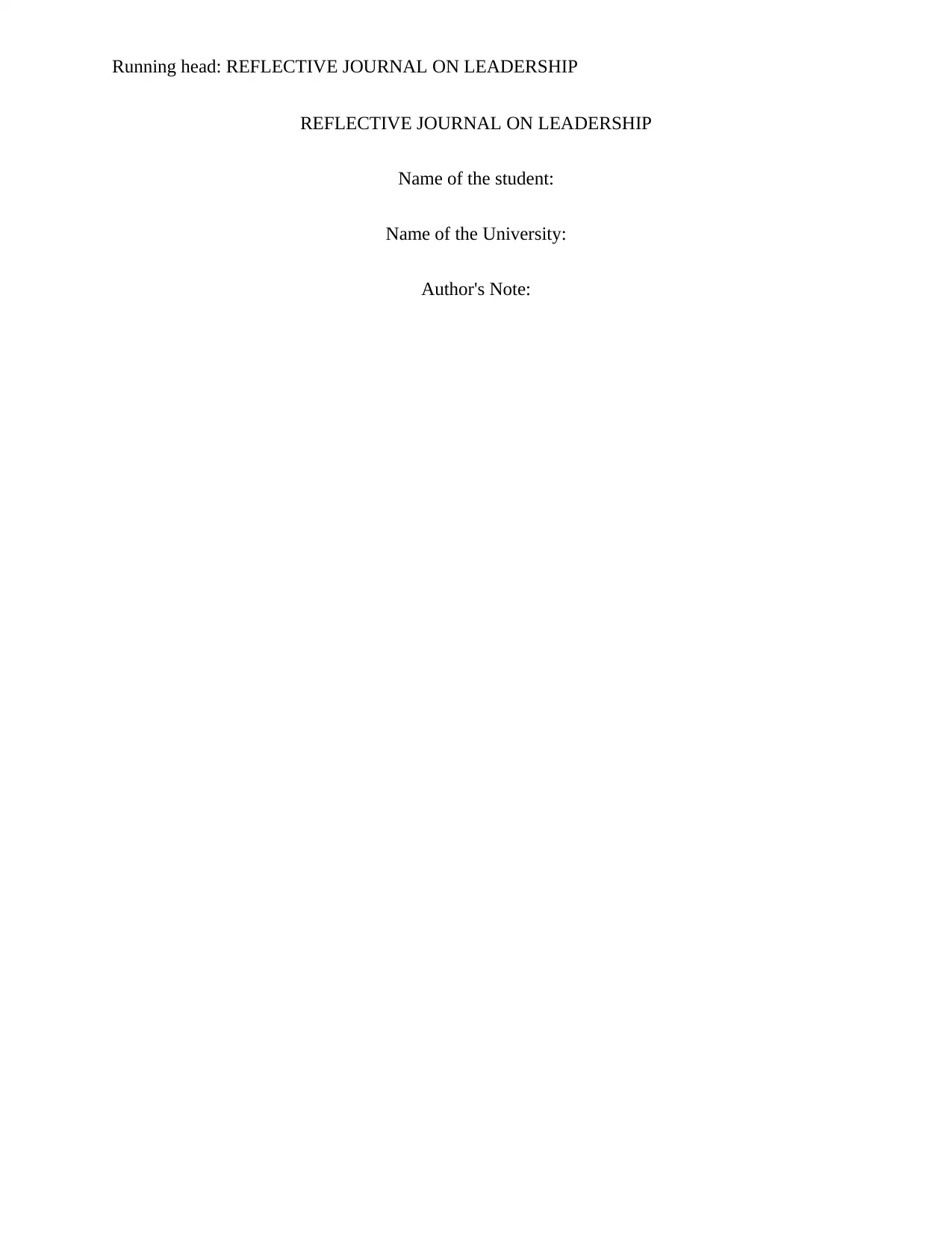
Running head: REFLECTIVE JOURNAL ON LEADERSHIP
REFLECTIVE JOURNAL ON LEADERSHIP
Name of the student:
Name of the University:
Author's Note:
REFLECTIVE JOURNAL ON LEADERSHIP
Name of the student:
Name of the University:
Author's Note:
Paraphrase This Document
Need a fresh take? Get an instant paraphrase of this document with our AI Paraphraser
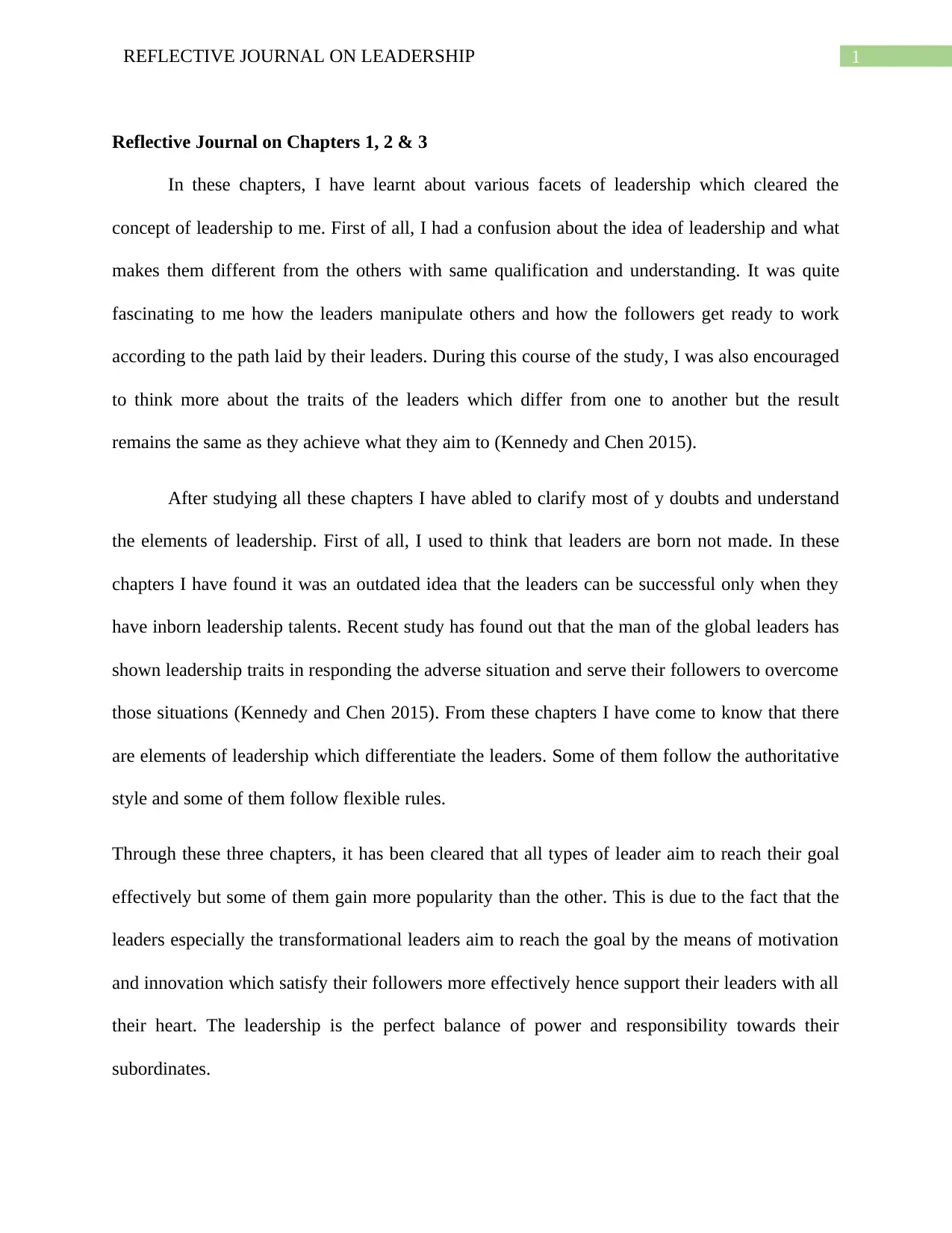
1REFLECTIVE JOURNAL ON LEADERSHIP
Reflective Journal on Chapters 1, 2 & 3
In these chapters, I have learnt about various facets of leadership which cleared the
concept of leadership to me. First of all, I had a confusion about the idea of leadership and what
makes them different from the others with same qualification and understanding. It was quite
fascinating to me how the leaders manipulate others and how the followers get ready to work
according to the path laid by their leaders. During this course of the study, I was also encouraged
to think more about the traits of the leaders which differ from one to another but the result
remains the same as they achieve what they aim to (Kennedy and Chen 2015).
After studying all these chapters I have abled to clarify most of y doubts and understand
the elements of leadership. First of all, I used to think that leaders are born not made. In these
chapters I have found it was an outdated idea that the leaders can be successful only when they
have inborn leadership talents. Recent study has found out that the man of the global leaders has
shown leadership traits in responding the adverse situation and serve their followers to overcome
those situations (Kennedy and Chen 2015). From these chapters I have come to know that there
are elements of leadership which differentiate the leaders. Some of them follow the authoritative
style and some of them follow flexible rules.
Through these three chapters, it has been cleared that all types of leader aim to reach their goal
effectively but some of them gain more popularity than the other. This is due to the fact that the
leaders especially the transformational leaders aim to reach the goal by the means of motivation
and innovation which satisfy their followers more effectively hence support their leaders with all
their heart. The leadership is the perfect balance of power and responsibility towards their
subordinates.
Reflective Journal on Chapters 1, 2 & 3
In these chapters, I have learnt about various facets of leadership which cleared the
concept of leadership to me. First of all, I had a confusion about the idea of leadership and what
makes them different from the others with same qualification and understanding. It was quite
fascinating to me how the leaders manipulate others and how the followers get ready to work
according to the path laid by their leaders. During this course of the study, I was also encouraged
to think more about the traits of the leaders which differ from one to another but the result
remains the same as they achieve what they aim to (Kennedy and Chen 2015).
After studying all these chapters I have abled to clarify most of y doubts and understand
the elements of leadership. First of all, I used to think that leaders are born not made. In these
chapters I have found it was an outdated idea that the leaders can be successful only when they
have inborn leadership talents. Recent study has found out that the man of the global leaders has
shown leadership traits in responding the adverse situation and serve their followers to overcome
those situations (Kennedy and Chen 2015). From these chapters I have come to know that there
are elements of leadership which differentiate the leaders. Some of them follow the authoritative
style and some of them follow flexible rules.
Through these three chapters, it has been cleared that all types of leader aim to reach their goal
effectively but some of them gain more popularity than the other. This is due to the fact that the
leaders especially the transformational leaders aim to reach the goal by the means of motivation
and innovation which satisfy their followers more effectively hence support their leaders with all
their heart. The leadership is the perfect balance of power and responsibility towards their
subordinates.
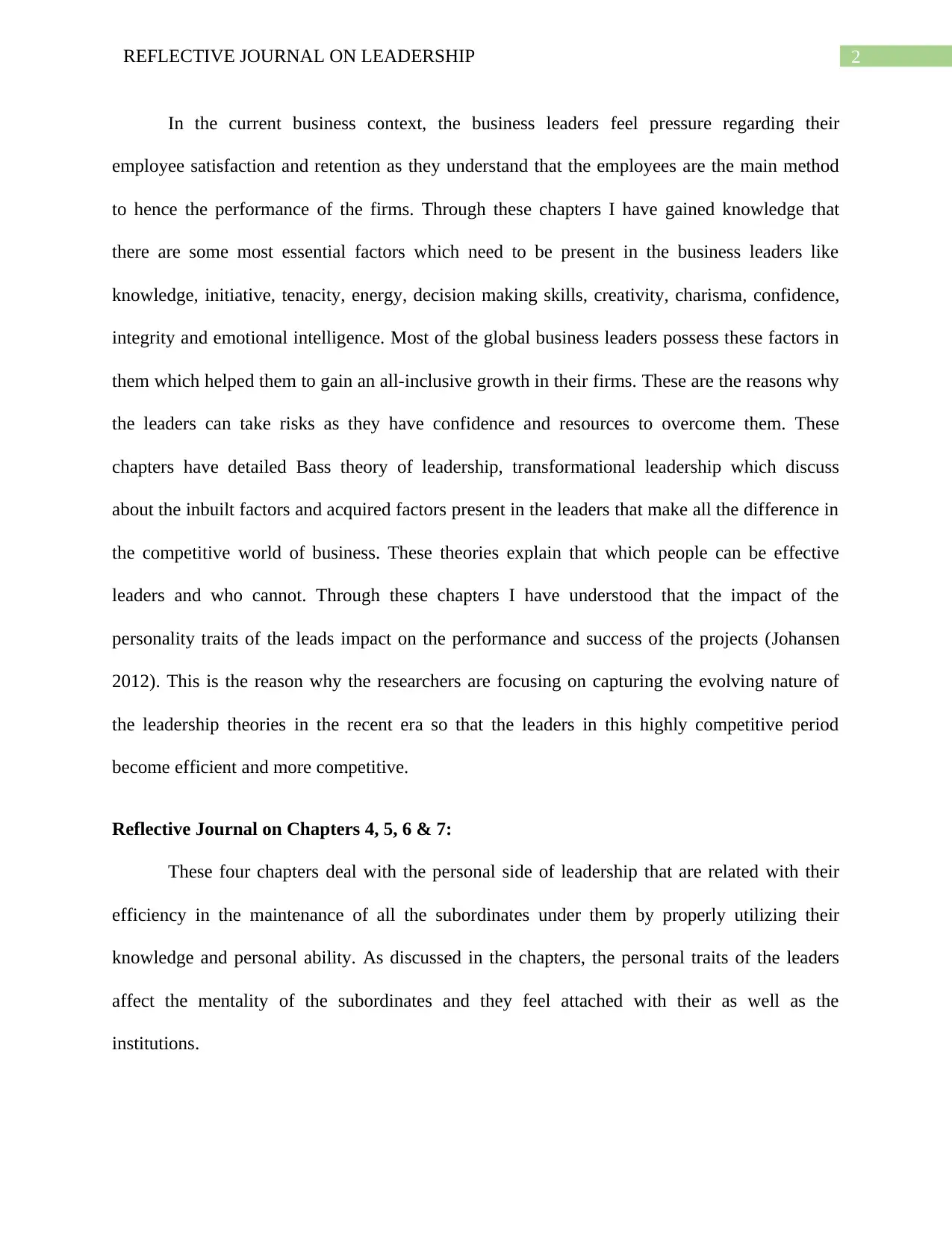
2REFLECTIVE JOURNAL ON LEADERSHIP
In the current business context, the business leaders feel pressure regarding their
employee satisfaction and retention as they understand that the employees are the main method
to hence the performance of the firms. Through these chapters I have gained knowledge that
there are some most essential factors which need to be present in the business leaders like
knowledge, initiative, tenacity, energy, decision making skills, creativity, charisma, confidence,
integrity and emotional intelligence. Most of the global business leaders possess these factors in
them which helped them to gain an all-inclusive growth in their firms. These are the reasons why
the leaders can take risks as they have confidence and resources to overcome them. These
chapters have detailed Bass theory of leadership, transformational leadership which discuss
about the inbuilt factors and acquired factors present in the leaders that make all the difference in
the competitive world of business. These theories explain that which people can be effective
leaders and who cannot. Through these chapters I have understood that the impact of the
personality traits of the leads impact on the performance and success of the projects (Johansen
2012). This is the reason why the researchers are focusing on capturing the evolving nature of
the leadership theories in the recent era so that the leaders in this highly competitive period
become efficient and more competitive.
Reflective Journal on Chapters 4, 5, 6 & 7:
These four chapters deal with the personal side of leadership that are related with their
efficiency in the maintenance of all the subordinates under them by properly utilizing their
knowledge and personal ability. As discussed in the chapters, the personal traits of the leaders
affect the mentality of the subordinates and they feel attached with their as well as the
institutions.
In the current business context, the business leaders feel pressure regarding their
employee satisfaction and retention as they understand that the employees are the main method
to hence the performance of the firms. Through these chapters I have gained knowledge that
there are some most essential factors which need to be present in the business leaders like
knowledge, initiative, tenacity, energy, decision making skills, creativity, charisma, confidence,
integrity and emotional intelligence. Most of the global business leaders possess these factors in
them which helped them to gain an all-inclusive growth in their firms. These are the reasons why
the leaders can take risks as they have confidence and resources to overcome them. These
chapters have detailed Bass theory of leadership, transformational leadership which discuss
about the inbuilt factors and acquired factors present in the leaders that make all the difference in
the competitive world of business. These theories explain that which people can be effective
leaders and who cannot. Through these chapters I have understood that the impact of the
personality traits of the leads impact on the performance and success of the projects (Johansen
2012). This is the reason why the researchers are focusing on capturing the evolving nature of
the leadership theories in the recent era so that the leaders in this highly competitive period
become efficient and more competitive.
Reflective Journal on Chapters 4, 5, 6 & 7:
These four chapters deal with the personal side of leadership that are related with their
efficiency in the maintenance of all the subordinates under them by properly utilizing their
knowledge and personal ability. As discussed in the chapters, the personal traits of the leaders
affect the mentality of the subordinates and they feel attached with their as well as the
institutions.
⊘ This is a preview!⊘
Do you want full access?
Subscribe today to unlock all pages.

Trusted by 1+ million students worldwide
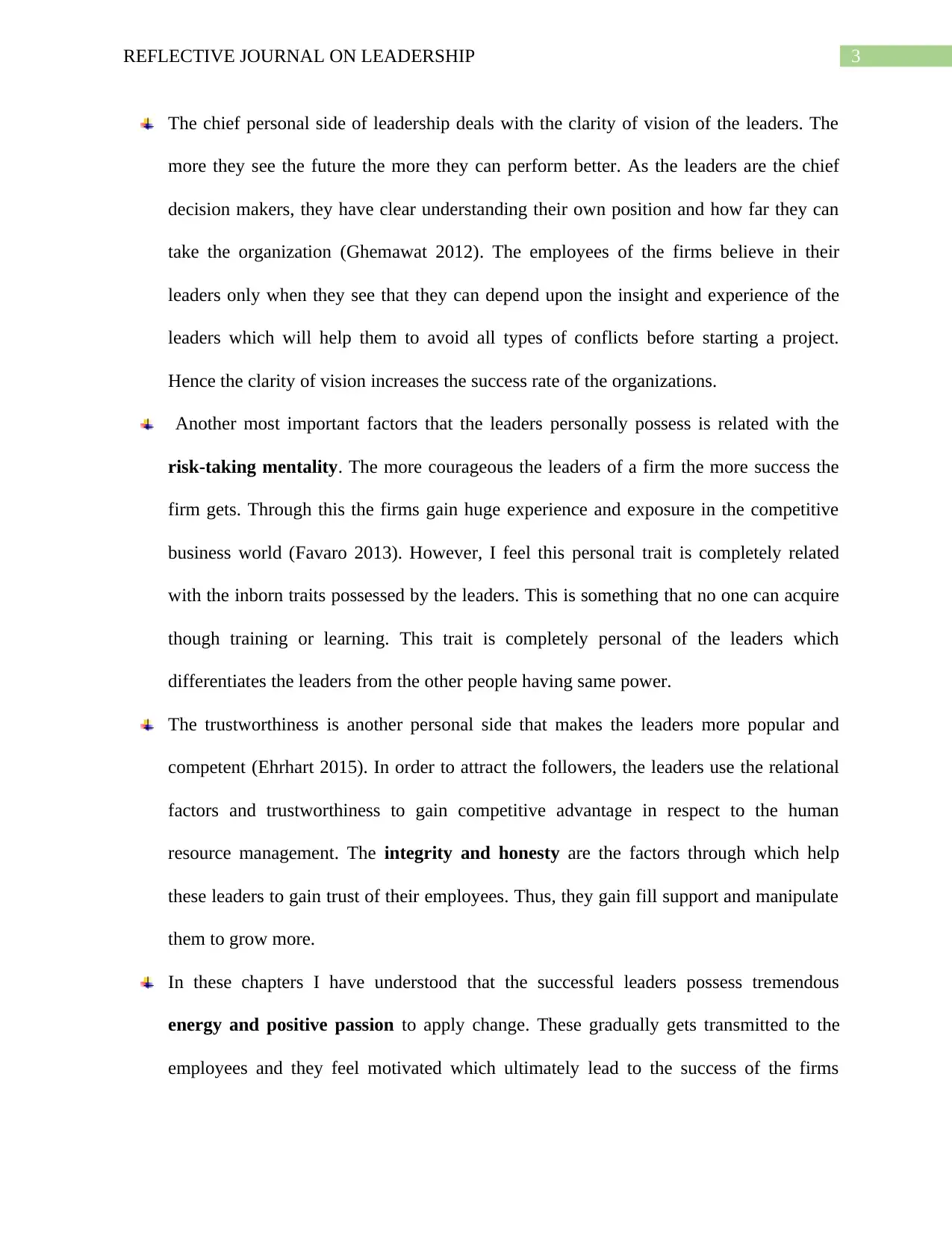
3REFLECTIVE JOURNAL ON LEADERSHIP
The chief personal side of leadership deals with the clarity of vision of the leaders. The
more they see the future the more they can perform better. As the leaders are the chief
decision makers, they have clear understanding their own position and how far they can
take the organization (Ghemawat 2012). The employees of the firms believe in their
leaders only when they see that they can depend upon the insight and experience of the
leaders which will help them to avoid all types of conflicts before starting a project.
Hence the clarity of vision increases the success rate of the organizations.
Another most important factors that the leaders personally possess is related with the
risk-taking mentality. The more courageous the leaders of a firm the more success the
firm gets. Through this the firms gain huge experience and exposure in the competitive
business world (Favaro 2013). However, I feel this personal trait is completely related
with the inborn traits possessed by the leaders. This is something that no one can acquire
though training or learning. This trait is completely personal of the leaders which
differentiates the leaders from the other people having same power.
The trustworthiness is another personal side that makes the leaders more popular and
competent (Ehrhart 2015). In order to attract the followers, the leaders use the relational
factors and trustworthiness to gain competitive advantage in respect to the human
resource management. The integrity and honesty are the factors through which help
these leaders to gain trust of their employees. Thus, they gain fill support and manipulate
them to grow more.
In these chapters I have understood that the successful leaders possess tremendous
energy and positive passion to apply change. These gradually gets transmitted to the
employees and they feel motivated which ultimately lead to the success of the firms
The chief personal side of leadership deals with the clarity of vision of the leaders. The
more they see the future the more they can perform better. As the leaders are the chief
decision makers, they have clear understanding their own position and how far they can
take the organization (Ghemawat 2012). The employees of the firms believe in their
leaders only when they see that they can depend upon the insight and experience of the
leaders which will help them to avoid all types of conflicts before starting a project.
Hence the clarity of vision increases the success rate of the organizations.
Another most important factors that the leaders personally possess is related with the
risk-taking mentality. The more courageous the leaders of a firm the more success the
firm gets. Through this the firms gain huge experience and exposure in the competitive
business world (Favaro 2013). However, I feel this personal trait is completely related
with the inborn traits possessed by the leaders. This is something that no one can acquire
though training or learning. This trait is completely personal of the leaders which
differentiates the leaders from the other people having same power.
The trustworthiness is another personal side that makes the leaders more popular and
competent (Ehrhart 2015). In order to attract the followers, the leaders use the relational
factors and trustworthiness to gain competitive advantage in respect to the human
resource management. The integrity and honesty are the factors through which help
these leaders to gain trust of their employees. Thus, they gain fill support and manipulate
them to grow more.
In these chapters I have understood that the successful leaders possess tremendous
energy and positive passion to apply change. These gradually gets transmitted to the
employees and they feel motivated which ultimately lead to the success of the firms
Paraphrase This Document
Need a fresh take? Get an instant paraphrase of this document with our AI Paraphraser
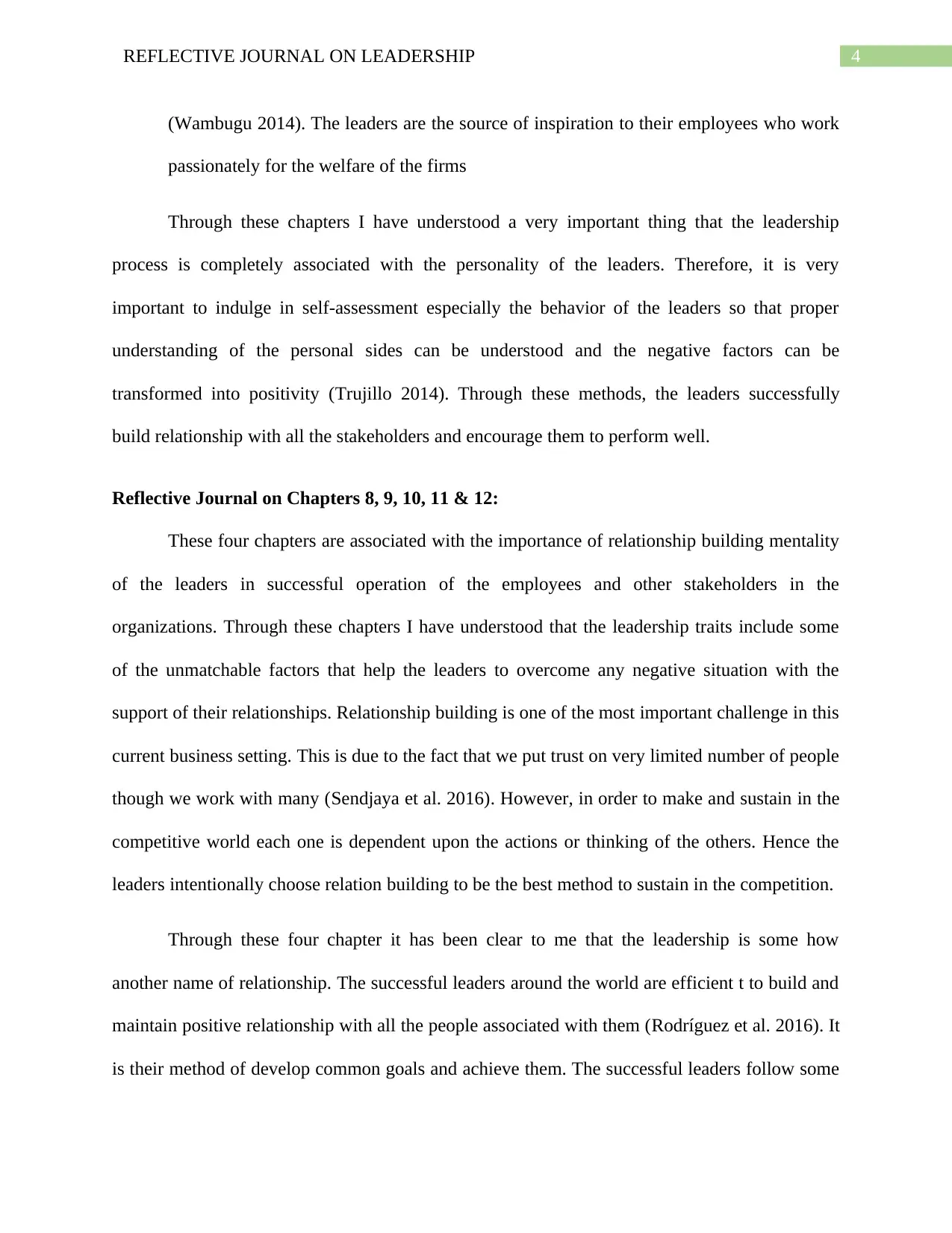
4REFLECTIVE JOURNAL ON LEADERSHIP
(Wambugu 2014). The leaders are the source of inspiration to their employees who work
passionately for the welfare of the firms
Through these chapters I have understood a very important thing that the leadership
process is completely associated with the personality of the leaders. Therefore, it is very
important to indulge in self-assessment especially the behavior of the leaders so that proper
understanding of the personal sides can be understood and the negative factors can be
transformed into positivity (Trujillo 2014). Through these methods, the leaders successfully
build relationship with all the stakeholders and encourage them to perform well.
Reflective Journal on Chapters 8, 9, 10, 11 & 12:
These four chapters are associated with the importance of relationship building mentality
of the leaders in successful operation of the employees and other stakeholders in the
organizations. Through these chapters I have understood that the leadership traits include some
of the unmatchable factors that help the leaders to overcome any negative situation with the
support of their relationships. Relationship building is one of the most important challenge in this
current business setting. This is due to the fact that we put trust on very limited number of people
though we work with many (Sendjaya et al. 2016). However, in order to make and sustain in the
competitive world each one is dependent upon the actions or thinking of the others. Hence the
leaders intentionally choose relation building to be the best method to sustain in the competition.
Through these four chapter it has been clear to me that the leadership is some how
another name of relationship. The successful leaders around the world are efficient t to build and
maintain positive relationship with all the people associated with them (Rodríguez et al. 2016). It
is their method of develop common goals and achieve them. The successful leaders follow some
(Wambugu 2014). The leaders are the source of inspiration to their employees who work
passionately for the welfare of the firms
Through these chapters I have understood a very important thing that the leadership
process is completely associated with the personality of the leaders. Therefore, it is very
important to indulge in self-assessment especially the behavior of the leaders so that proper
understanding of the personal sides can be understood and the negative factors can be
transformed into positivity (Trujillo 2014). Through these methods, the leaders successfully
build relationship with all the stakeholders and encourage them to perform well.
Reflective Journal on Chapters 8, 9, 10, 11 & 12:
These four chapters are associated with the importance of relationship building mentality
of the leaders in successful operation of the employees and other stakeholders in the
organizations. Through these chapters I have understood that the leadership traits include some
of the unmatchable factors that help the leaders to overcome any negative situation with the
support of their relationships. Relationship building is one of the most important challenge in this
current business setting. This is due to the fact that we put trust on very limited number of people
though we work with many (Sendjaya et al. 2016). However, in order to make and sustain in the
competitive world each one is dependent upon the actions or thinking of the others. Hence the
leaders intentionally choose relation building to be the best method to sustain in the competition.
Through these four chapter it has been clear to me that the leadership is some how
another name of relationship. The successful leaders around the world are efficient t to build and
maintain positive relationship with all the people associated with them (Rodríguez et al. 2016). It
is their method of develop common goals and achieve them. The successful leaders follow some
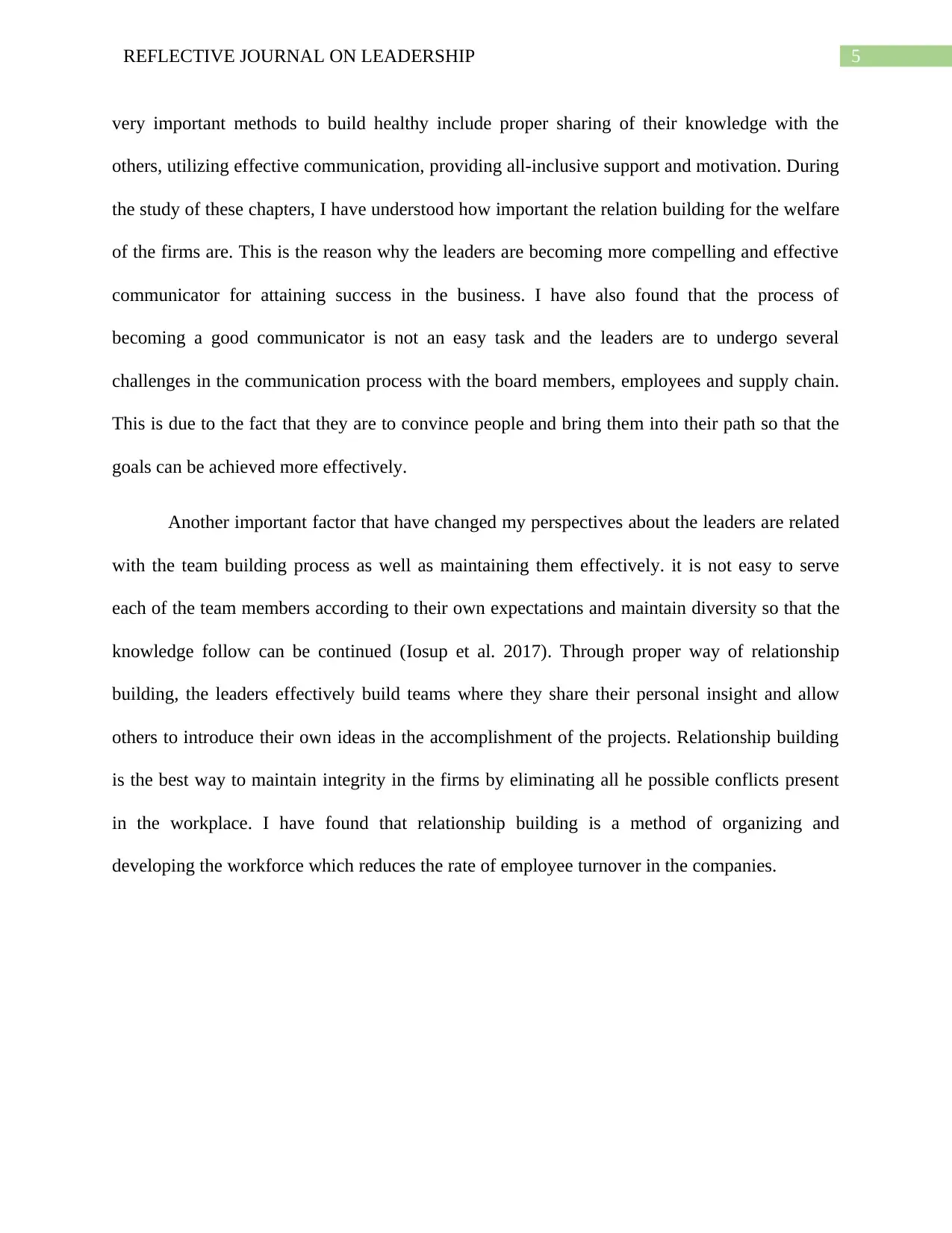
5REFLECTIVE JOURNAL ON LEADERSHIP
very important methods to build healthy include proper sharing of their knowledge with the
others, utilizing effective communication, providing all-inclusive support and motivation. During
the study of these chapters, I have understood how important the relation building for the welfare
of the firms are. This is the reason why the leaders are becoming more compelling and effective
communicator for attaining success in the business. I have also found that the process of
becoming a good communicator is not an easy task and the leaders are to undergo several
challenges in the communication process with the board members, employees and supply chain.
This is due to the fact that they are to convince people and bring them into their path so that the
goals can be achieved more effectively.
Another important factor that have changed my perspectives about the leaders are related
with the team building process as well as maintaining them effectively. it is not easy to serve
each of the team members according to their own expectations and maintain diversity so that the
knowledge follow can be continued (Iosup et al. 2017). Through proper way of relationship
building, the leaders effectively build teams where they share their personal insight and allow
others to introduce their own ideas in the accomplishment of the projects. Relationship building
is the best way to maintain integrity in the firms by eliminating all he possible conflicts present
in the workplace. I have found that relationship building is a method of organizing and
developing the workforce which reduces the rate of employee turnover in the companies.
very important methods to build healthy include proper sharing of their knowledge with the
others, utilizing effective communication, providing all-inclusive support and motivation. During
the study of these chapters, I have understood how important the relation building for the welfare
of the firms are. This is the reason why the leaders are becoming more compelling and effective
communicator for attaining success in the business. I have also found that the process of
becoming a good communicator is not an easy task and the leaders are to undergo several
challenges in the communication process with the board members, employees and supply chain.
This is due to the fact that they are to convince people and bring them into their path so that the
goals can be achieved more effectively.
Another important factor that have changed my perspectives about the leaders are related
with the team building process as well as maintaining them effectively. it is not easy to serve
each of the team members according to their own expectations and maintain diversity so that the
knowledge follow can be continued (Iosup et al. 2017). Through proper way of relationship
building, the leaders effectively build teams where they share their personal insight and allow
others to introduce their own ideas in the accomplishment of the projects. Relationship building
is the best way to maintain integrity in the firms by eliminating all he possible conflicts present
in the workplace. I have found that relationship building is a method of organizing and
developing the workforce which reduces the rate of employee turnover in the companies.
⊘ This is a preview!⊘
Do you want full access?
Subscribe today to unlock all pages.

Trusted by 1+ million students worldwide
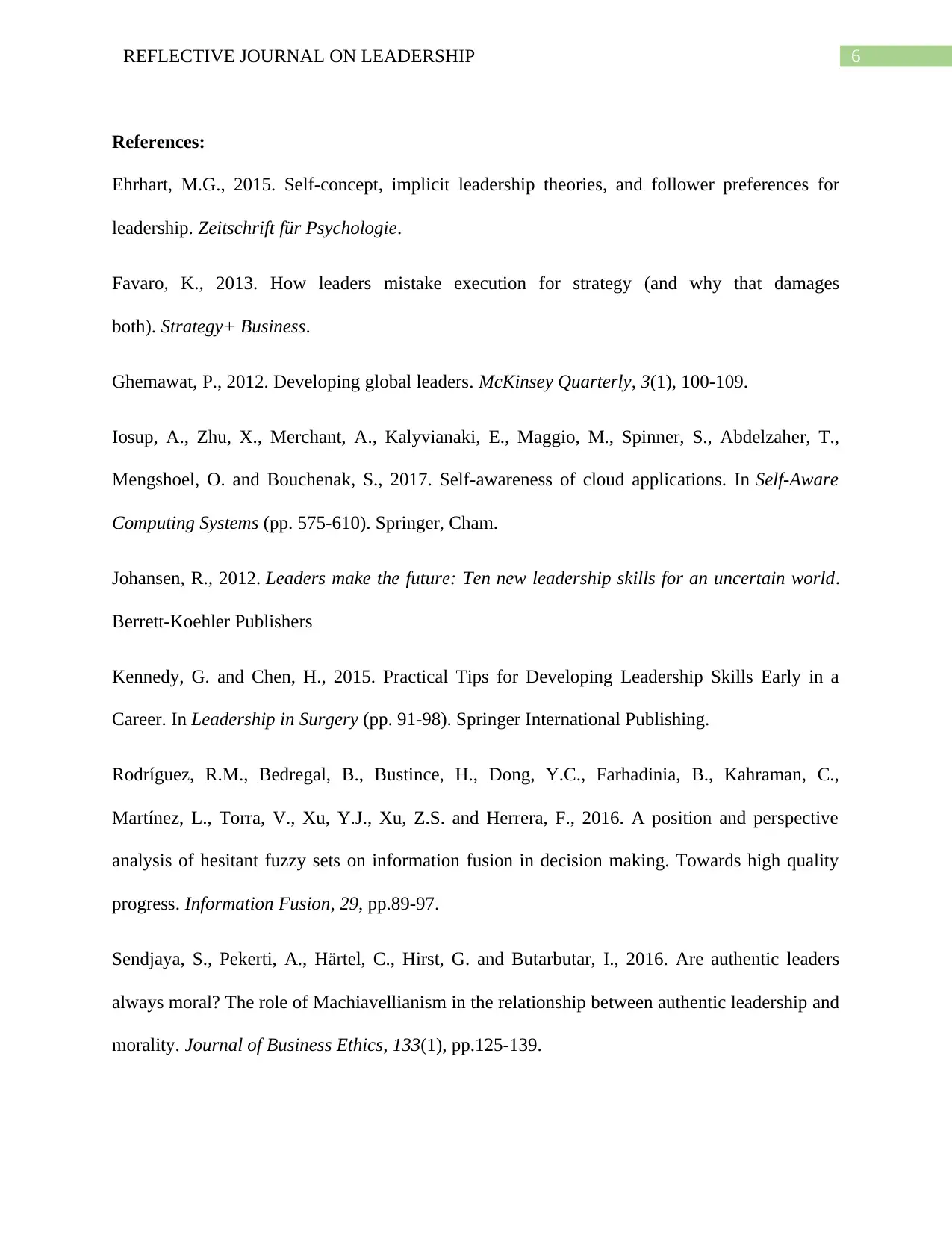
6REFLECTIVE JOURNAL ON LEADERSHIP
References:
Ehrhart, M.G., 2015. Self-concept, implicit leadership theories, and follower preferences for
leadership. Zeitschrift für Psychologie.
Favaro, K., 2013. How leaders mistake execution for strategy (and why that damages
both). Strategy+ Business.
Ghemawat, P., 2012. Developing global leaders. McKinsey Quarterly, 3(1), 100-109.
Iosup, A., Zhu, X., Merchant, A., Kalyvianaki, E., Maggio, M., Spinner, S., Abdelzaher, T.,
Mengshoel, O. and Bouchenak, S., 2017. Self-awareness of cloud applications. In Self-Aware
Computing Systems (pp. 575-610). Springer, Cham.
Johansen, R., 2012. Leaders make the future: Ten new leadership skills for an uncertain world.
Berrett-Koehler Publishers
Kennedy, G. and Chen, H., 2015. Practical Tips for Developing Leadership Skills Early in a
Career. In Leadership in Surgery (pp. 91-98). Springer International Publishing.
Rodríguez, R.M., Bedregal, B., Bustince, H., Dong, Y.C., Farhadinia, B., Kahraman, C.,
Martínez, L., Torra, V., Xu, Y.J., Xu, Z.S. and Herrera, F., 2016. A position and perspective
analysis of hesitant fuzzy sets on information fusion in decision making. Towards high quality
progress. Information Fusion, 29, pp.89-97.
Sendjaya, S., Pekerti, A., Härtel, C., Hirst, G. and Butarbutar, I., 2016. Are authentic leaders
always moral? The role of Machiavellianism in the relationship between authentic leadership and
morality. Journal of Business Ethics, 133(1), pp.125-139.
References:
Ehrhart, M.G., 2015. Self-concept, implicit leadership theories, and follower preferences for
leadership. Zeitschrift für Psychologie.
Favaro, K., 2013. How leaders mistake execution for strategy (and why that damages
both). Strategy+ Business.
Ghemawat, P., 2012. Developing global leaders. McKinsey Quarterly, 3(1), 100-109.
Iosup, A., Zhu, X., Merchant, A., Kalyvianaki, E., Maggio, M., Spinner, S., Abdelzaher, T.,
Mengshoel, O. and Bouchenak, S., 2017. Self-awareness of cloud applications. In Self-Aware
Computing Systems (pp. 575-610). Springer, Cham.
Johansen, R., 2012. Leaders make the future: Ten new leadership skills for an uncertain world.
Berrett-Koehler Publishers
Kennedy, G. and Chen, H., 2015. Practical Tips for Developing Leadership Skills Early in a
Career. In Leadership in Surgery (pp. 91-98). Springer International Publishing.
Rodríguez, R.M., Bedregal, B., Bustince, H., Dong, Y.C., Farhadinia, B., Kahraman, C.,
Martínez, L., Torra, V., Xu, Y.J., Xu, Z.S. and Herrera, F., 2016. A position and perspective
analysis of hesitant fuzzy sets on information fusion in decision making. Towards high quality
progress. Information Fusion, 29, pp.89-97.
Sendjaya, S., Pekerti, A., Härtel, C., Hirst, G. and Butarbutar, I., 2016. Are authentic leaders
always moral? The role of Machiavellianism in the relationship between authentic leadership and
morality. Journal of Business Ethics, 133(1), pp.125-139.
Paraphrase This Document
Need a fresh take? Get an instant paraphrase of this document with our AI Paraphraser
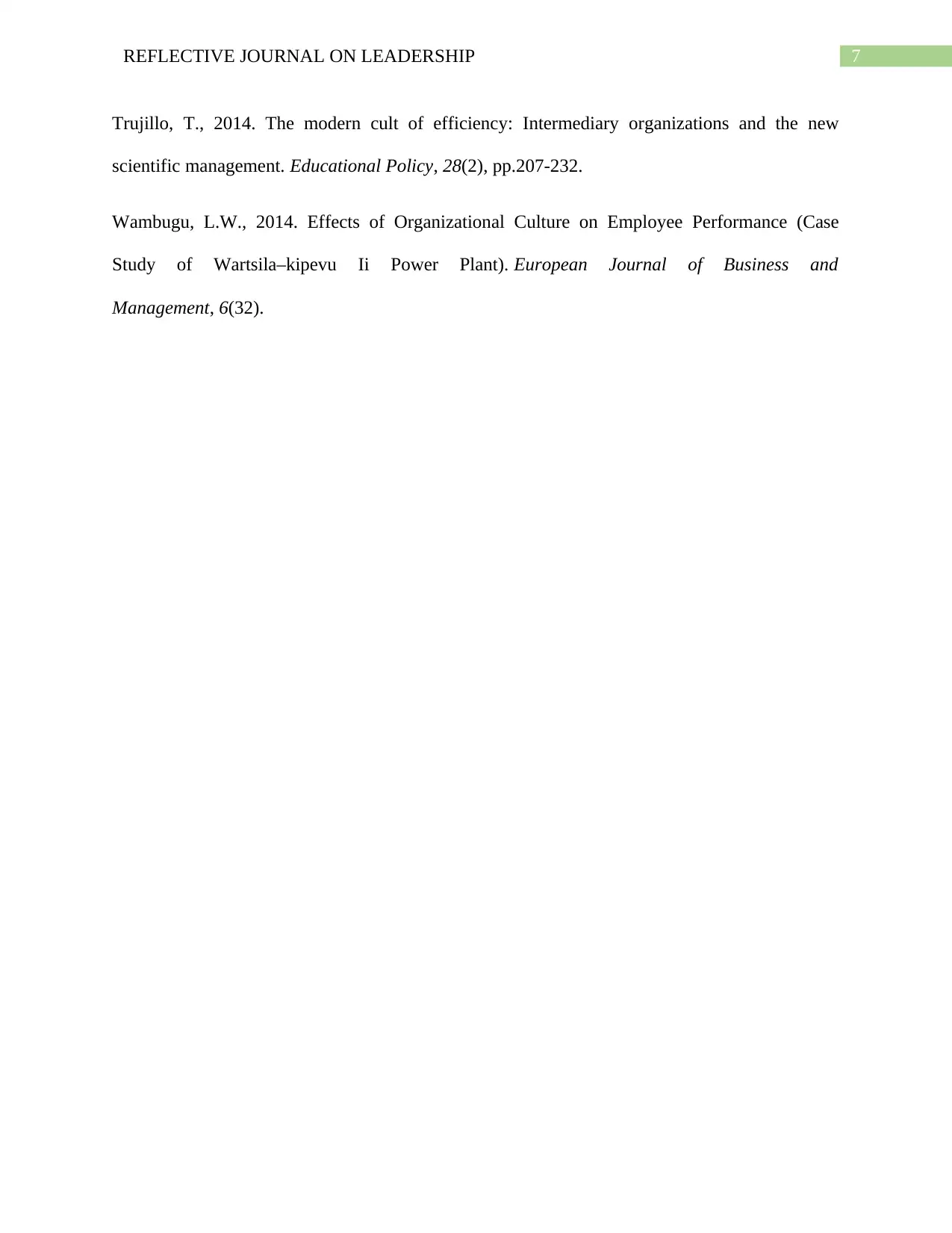
7REFLECTIVE JOURNAL ON LEADERSHIP
Trujillo, T., 2014. The modern cult of efficiency: Intermediary organizations and the new
scientific management. Educational Policy, 28(2), pp.207-232.
Wambugu, L.W., 2014. Effects of Organizational Culture on Employee Performance (Case
Study of Wartsila–kipevu Ii Power Plant). European Journal of Business and
Management, 6(32).
Trujillo, T., 2014. The modern cult of efficiency: Intermediary organizations and the new
scientific management. Educational Policy, 28(2), pp.207-232.
Wambugu, L.W., 2014. Effects of Organizational Culture on Employee Performance (Case
Study of Wartsila–kipevu Ii Power Plant). European Journal of Business and
Management, 6(32).
1 out of 8
Related Documents
Your All-in-One AI-Powered Toolkit for Academic Success.
+13062052269
info@desklib.com
Available 24*7 on WhatsApp / Email
![[object Object]](/_next/static/media/star-bottom.7253800d.svg)
Unlock your academic potential
Copyright © 2020–2025 A2Z Services. All Rights Reserved. Developed and managed by ZUCOL.





